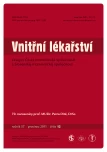Screening of celiac disease in patients with osteoporosis and osteopenia
Authors:
P. Fojtík 1; P. Novosad 2; M. Kliment 1; P. Hrdý 2; Á. Bóday 3; R. Richterová 3; O. Urban 1,4
Authors‘ workplace:
Centrum péče o zažívací trakt, Vítkovická nemocnice, a. s., Ostrava-Vítkovice, přednosta MUDr. Ondřej Urban, Ph. D.
1; Osteologické centrum Mediekos Labor, a. s., Zlín, přednosta MUDr. Pavel Novosad
2; Laboratoř molekulární biologie, vedoucí RNDr. Radmila Richterová, P&R Lab, a. s., Nový Jičín, ředitelka RNDr. Magdalena Uvírová
3; Lékařská fakulta Ostravské univerzity Ostrava, děkan doc. MUDr. Arnošt Martínek, CSc.
4
Published in:
Vnitř Lék 2011; 57(12): 1000-1005
Category:
70th birthday of prof. MUDr. Petr Dítě, DrSc.
Overview
The celiac disease is traditionally viewed as the children’s disease with a typical form accompanied mainly by intestinal symptoms and malabsorption. This opinion is still generally accepted by the medical community. Findings based on the area-wide screening show that the prevalence has risen from the original 1 : 1 000–1 500 to 1 : 70–550. The average prevalence in the western countries is nearly 1 : 100. The prevalence of the celiac disease in the Czech republic is estimated to be approximately 1 : 200–250. It means that the number of people in the Czech republic who are likely to be affected is about 40,000–50,000 people. Currently only 10–15% of the total number of the ill people are diagnosed and monitored. Adult patients represent the main diagnostic problem because their clinical pictures are individual and the main symptoms are atypical (nonenteral). These are anaemia (mainly sideropnic), early/premature osteoporosis, herpetiformic (Duhring) dermatitis, polyneurititis, ataxia, depression, behavioural disorders, menstrual cycle disorders and infertility. Therefore our attention is currently focused on the screening of these groups of subjects. The purpose of our study was to check the frequency of the celiac disease with patients with diagnosed osteoporosis and osteopenia. In our study we have confirmed the assumption that the prevalence of the celiac disease in the group of subjects was 1 : 50, which means that 2.2% of patients with osteoporosis and osteopenia are affected by celiac sprue and therefore screening examination of these patients with the subsequent causal treatment (gluten-free diet) is recommended.
Key words:
celiac disease – targeted screening – risk groups and disease – osteoporosis – osteopenia – secondary osteoporosis
Sources
1. Green P, Cellier CH et al. Celiac Disease. N Engl J Med 2007; 357: 1731–1743.
2. Frič P, Nevoral J. Cílený screening celiakie. Interní Med 2009; 11: 484–487.
3. Vyskočil V. Osteoporóza a ostatní nejčastější metabolická onemocnění skeletu. Praha: Galén 2009: 1–14.
4. Broulík P. Osteoporóza a její léčba. Praha: Jessenius Maxdorf 2009: 9–21.
5. Bureš J. Metabolická kostní nemoc u chorob gastrointestinálního traktu. Postgrad Med 2009; 11: 76–78.
6. Gnauck R. World Health Organization criteria for screening. New York: Raven Press 1980: 175–180.
7. Vančíková Z, Chlumecký V, Sokol D et al. The serologic screening for celiac disease in the general population(Blood donors) and in some high- risk groups of adults (patients with autoimmune disease, osteoporosis and infertility) in the Czech Republic. Fol Microbiol 2002; 47: 753–758.
8. Kotalová R, Nevoral J, Valtrová V et al. Prevalence celiakie mezi rodiči a sourozenci dětí s celiakií. Čes Slov Pediat 2002; 57: 415–418.
9. Kolek A, Vospělová J, Hermanová Z et al. Celiac disease – incidence in children and adolescents in Moravia, Czech Republic. J Pediatr Gastroenterol Nutr 2003; 36: 506–507.
10. Goldberg D, Krasyak D, Fasano A et al. Screening for celiac disease in family members: is follow up testing necesary? Dig Dis Sci 2007; 52: 1082–1086.
11. Prokopová L. Celiakie – co má vědět ambulantní internista. Interní Med 2008; 10: 233–239.
12. Rostom A, Dubé C, Cranney A et al. The diagnostic accuracy of serologic tests for celiac disease: a systematic review. Gastroenterology 2005; 128 (Suppl 1): S38–S46.
13. Frič P. Endoskopická diagnostika celiakální sprue. Endoskopie 2002; 11: 69–73.
14. Marsh MN. Gluten major histocompatibillity complex and the small intestine: a moleculare and immunobiologic approach to the spectrum of gluten sensitivity (celiac sprue). Gastroenteology 1992; 102: 330–354.
15. Hill ID, Dirks MH, Liptak GS et al. North American Society for Pediatric Gastroenterology, Hepatology and Nutrition. Guideline for the diagnosis and treatment of celiac disease in children recomendations of the North American Society for Pediatric Gastroenterology, Hepatology and Nutrition. J Pediatr Gastroenterol Nutr 2005; 40: 1–12.
16. Stenson WF, Newberry R, Lorenz R. Increase Prevalence of Celiac Disease and Need for Routine Screening among Patients With Osteoporosis. Arch Intern Med 2005; 165: 393–399.
17. Ferguson A, Arranz E, O’Mahoney S. Clinical and pathological spectrum of coeliac disease – active, silent, latent, potencial. Gut 1993; 34: 150–151.
18. Lewis NR, Scott BB. Guidelines for osteoporosis in inflammatory bowel disease and coeliac disease. BSG 2007. http://www.bsg.org.uk/clinical-guidelines/ibd/guidelines-for-osteoporosis-in-inflammatory-bowel-disease-and-coeliac-disease.html.
19. Nieves J. Osteoporosis: The role of micronutrients. Clinical Nutrion 2005; 81: 1232S–1239S.
Labels
Diabetology Endocrinology Internal medicineArticle was published in
Internal Medicine

2011 Issue 12
Most read in this issue
- Neuroendocrine tumours of the upper gastrointestinal tract, characteristics and comparison of localization diagnostics
- Complications of endoscopic retrograde cholangiopancreatography and how to minimize them
- Aldosterone as an endogenous cardiovascular toxin and the options for its therapeutic management
- Do we need endoscopic sclerotherapy of oesophageal varices or the last turn off the light
